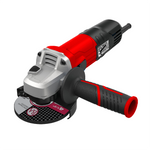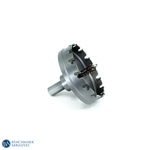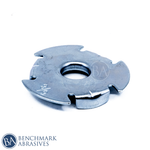
Disc Grinder Vs Angle Grinder

Surfaces are ground, polished, and cut using disc and angle grinders. People often mix up the two because even angle grinders have discs. People may not understand the distinction between an angle grinder and a disc grinder unless they have visited a workshop or worked on one themselves. The term "disc grinder" is commonly used to refer to both angle grinders and true disc grinders.
We will discuss the differences between disc grinders and angle grinders in this article, and the situations in which each is used.
Disc Grinders
A grinding disc is connected to a fixed metal cutting tool called a disc grinder. When operating a disc grinder, the workpiece is held in the hands or with a tool for safety purposes. You can do work more precisely in this manner. You can also use it for cutting tasks similar to those performed with an angle grinder. Typically, the cooling liquid is kept on hand in disc grinders to cool the workpiece while being ground.
The price of a disc grinder is its biggest drawback because even the greatest angle grinders cost only a small portion of what a disc grinder does. Additionally, disc grinders use more power and demand more room. Only experts use disc grinders in their workshops due to these factors, and the general public prefers angle grinders.
Pros of Disc Grinders
- Suitable for accurate cuts: Disc grinders are perfect for giving clean and accurate cuts due to their stationery nature. It is perfectly suitable for workpieces requiring fine details, shaping, and finishing projects.
- High speed and power: Disc grinders are good at producing high speed and power which efficiently and quickly remove material and generate a smooth finish even on tougher materials.
Cons of Disc Grinders
- Not portable: Disc grinders are less portable compared to angle grinders due to their stationery design. Also, they are not suitable for working in large and complex spaces.
- Not flexible: disc grinders are not as flexible as compared to angle grinders. It is mainly designed for grinding projects and is not suitable for shaping and cutting metal.
- Difficult to use: due to its high speed and power and stationery design, it requires proper skill and knowledge to work with.
Angle Grinder
A handheld power tool called an angle grinder is used when precise grinding or cutting is not necessary. It is frequently utilized to carry out offensive operations that are smoothed out using other precision instruments. The fact that an angle grinder is portable and simple to use is a major benefit. The fact that it is lightweight further contributes to its appeal to most typical households.
Compared to a disc grinder, it is also more affordable to use and buy, and you can find various popular angle grinders for a much lower price. Additionally, because less storage space is needed, it is appropriate for general use. Its versatility is another major advantage—you can cut, grind, deburr, and even put a sanding disc on an angle grinder to handle basic surface preparation or material removal. This adaptability makes it a practical choice for both metalwork and light woodworking tasks, especially when precision isn’t the top priority.
Pros of Angle Grinders
- Versatility: Angle grinders are highly versatile tools compared to disc grinders. It works beyond grinding. It has several applications including cutting various materials like metal, concrete, etc., deburring, removing rust and paint, and polishing surfaces.
- Portable: Angle grinders and compact and portable making it easier to work in tight spaces.
- Easy to operate: angle grinders are comparatively easier to operate than disc grinders.
Cons of Angle Grinders
- Careful while operating: be careful while operating angle grinders as there are risks of flying Debris and kickbacks. Always wear appropriate safety gear.
- Less accurate: angle grinders are less accurate due to their handheld nature
- Not suitable for heavy-duty tasks: angle grinders are not ideal for heavy-duty projects or less accurate on tough materials.
Disc Grinder Vs. Angle Grinder: Comparisons
The main distinction between the two is that an angle grinder is a handheld, portable tool, whereas a disc grinder is a sturdy piece of machinery. A disc grinder is typically used for precision work on smaller workpieces, whereas an angle grinder is used for rough cutting and grinding. This fundamental distinction causes all the other differences, such as design, size, power, attachments, etc.
1. Based on Design
The contrast in design between the two is the most notable. Both have been created with a variety of functions in mind. Compared to a disc grinder, the discs used in an angle grinder are thinner and more abrasive. The workpiece is secured on a vise and is intended to be held in the hands while working. Angle grinders get their name from the disc's placement at a right angle to the handle's axis.
To protect the worker's eyes and keep grinding sparks from hitting his face, a safety guard case is positioned around the grinding discs. The disc's edge can be used as a cutting tool, while the face is utilized for polishing or grinding surfaces. The best grinding tools available are those featuring a variety of safety measures to safeguard the user in the event of an accident.
On the other hand, a disc grinder is fixed in one place and typically employed for precision work. When a disc is turned on, it rotates since it is mounted on a fixed quantity. In this instance, the workpiece is held in the hands. This aids in enhancing the accuracy of tasks like metal polishing that can be completed on this grinder. It typically has a transparent plastic or glass shield to shield the user's eyes.
2. Based on Size
Angle grinders are substantially more compact than disc grinders because they are handled. The size of the discs utilized in an angle grinder also varies. Disc grinders often have thicker discs than angle grinders do.
3. Based on Power
The size of an angle grinder is limited because it is portable. Due to this, even the best angle grinders cannot match fixed disc grinders in terms of power. Another factor that is accountable for this is safety. A handheld angle grinder will grow in size and become more hazardous to use as its power increases. These restrictions do not apply to disc grinders, which can be built with any level of durability.
4. Based on Attachments
It is commonly known that angle grinders are very versatile. The best angle grinders are those that can accommodate various attachment types. Angle grinders can use a variety of discs for both grinding and cutting operations. Many more types of cutting discs can be mounted to an angle grinder than to a disc grinder. Angle grinders are seen as more adaptable than disc grinders, which are often utilized for a specific purpose.
5. Based on Speed
The RPM of disc grinders is higher than that of angle grinders because the disc grinders have more power. For safety reasons, the RPM of a portable angle grinder is lower, with even the best models operating at speeds of no more than 3000 RPM. With the disc grinder, there are no such restrictions, and as long as safety precautions are taken, the speed can be as high as necessary.
Related Article: Understanding RPM Ratings on Abrasive Tools
CONCLUSION
The article shows that compact disc grinders are favored for industrial-grade precise work and for polishing or cutting small things because we can use our hands to grind the workpiece. However, angle grinders are more adaptable and less expensive to acquire and operate.
Angle grinders allow for more accessories while using less power and storage space. Another benefit of an angle grinder is its portability. These data allow us to choose the necessary grinder with ease.



































































